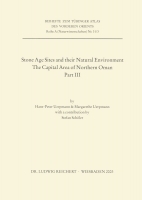Search
Uerpmann, Hans-Peter; Uerpmann, Margarethe
In cooperation with: Schöler, Stefan
Stone Age Sites and their Natural Environment
The Capital Area of Northern Oman. Part III
2003
20.0 x 28.0 cm, 280 p., 169 illustrations b/w, paperback / softback
ISBN: 9783895003738
20.0 x 28.0 cm, 280 p., 169 illustrations b/w, paperback / softback
88,00 €
ISBN: 9783895003738
Short Description
This volume presents the data and interpretations which served as a basis for part 4 (Stone Age Settlements on the Coast of Ra’s al-Hamra. Masqat, Oman) of TAVO Map B I 8 dealing with site ecologies of late foragers in the Middle East. It contains the first comprehensive presentation of findings and oberservations made at Late Stone Age sites in the Capital Area of Northern Oman. The beginnings of an intensive exploitation of marine resources, characterising this area till today, are observed during that period. The earliest evidence for the presence of modern humans is radiocarbon-dated to about 9000 BC. Neolithic settlements on the coast flourish from the 5th millennium BC onward and continue into the 3rd millennium BC in the form of an „aceramic Bronze Age“. Artefacts made of stone and shell, including tools and adornments, are presented and interpreted as well as the remains of subsistence activities, which comprise bones of mammals, birds, sea turtles and fish plus shells of marine molluscs. The volume concludes with a chapter on human and environmental history during the first 6 millennia of the Holocene.Description
No english description available. Showing german descriptionDas Werk behandelt Archäologie und Umwelt im Norden des Sultanats Oman für den Zeitraum vom Ende der letzten Eiszeit bis zum Beginn der Bronzezeit. Es stützt sich dabei auf die Tübinger Ausgrabungen und Geländeforschungen zwischen 1970 und 1988, deren Ergebnisse hier abschließend vorgelegt werden, und stellt sie in den Zusammenhang der neuen Erkenntnisse, die in der Zwischenzeit für diesen Zeitraum in Südost-Arabien gewonnen sind. Besonders wichtig ist der Nachweis einer vorneolithischen Besiedlung ab etwa 9000 BC. Die Neolithisierung erfolgte spätestens am Übergang vom 6. zum 5. vorchristlichen Jahrtausend durch die Einwanderung von nomadischen Rinder-, Schaf- und Ziegenhirten, die Verbindungen zum Fruchtbaren Halbmond gehabt haben müssen. Bereits im 5. Jahrtausend v. Chr. entwickelte diese Bevölkerung eine spezifische Wirtschaftsform, die sich stark auf die Einbeziehung von marinen Ressourcen stützte. Zusammen mit der Haustierhaltung und der Nutzung sonstiger ökologischer Nischen erlaubte die Fischerei trotz der insgesamt marginalen Umweltverhältnisse eine zunehmende Sesshaftigkeit.
Breiter Raum wird der Darstellung der Funde und Befunde aus jungsteinzeitlichen und akeramisch-bronzezeitlichen Siedlungsplätzen in der Gegend um die omanische Hauptstadt Musqat gewidmet. Vergleichend werden Siedlungen des Gebiets um Quriyar behandelt. Eine ausführlich kommentierte 14C-Chronologie liefert die zeitliche Einordnung der Fundstellen. Topographische und stratigraphische Angaben erlauben die Einordnung der zahlreichen Feuerstein- und sonstigen Steinartefakte sowie der Schmuck- und Gebrauchsgegenstände aus Perlmutt und anderen Muschelschalen, die sowohl tabellarisch wie in vielen Zeichnungen dokumentiert werden. Ein gesonderter Beitrag von Stephan Schöler stellt mineralogische und geochemische Untersuchungen an Schmuckobjekten des 4. Jahrtausends v. Chr. vor und beurteilt die mögliche Herkunft der Rohmaterialien.
Der andere Schwerpunkt der Arbeit ist die Auswertung der anthropogenen Tierreste sowohl aus den Tübinger Grabungen wie auch aus den Grabungen eines italienischen Teams an den Fundstellen des Ra’s al-Hamra bei Musqat. Tausende von Fisch- und Schildkrötenknochen geben detaillierte Hinweise auf den hochspezialisierten Nahrungserwerb einer Menschengruppe am damaligen Rand der menschlichen Ökumene. Abschließend werden die Ergebnisse in den Rahmen der Klimaentwicklung gestellt und mit denen anderer Fundstellen verglichen. Es ergibt sich das faszinierende Bild einer eigenständigen Entwicklung in einem Teilraum der Arabischen Halbinsel, der einerseits durch das wüstenhafte Hinterland isoliert war, andererseits aber durch maritime Kontakte die frühe Kulturentwicklung des Raumes zwischen Mesopotamien und dem Industal seit der späten Steinzeit mit bestimmt hat.






 Neuerscheinungen 2023/2024
Neuerscheinungen 2023/2024
 Gesamtverzeichnis 2023/2024
Gesamtverzeichnis 2023/2024
 Katalog Oriental Studies & Linguistics
Katalog Oriental Studies & Linguistics
 Mittelalter
Mittelalter
 Deutsche Inschriften
Deutsche Inschriften
 Musiktherapie
Musiktherapie
 Literaturen im Kontext
Literaturen im Kontext